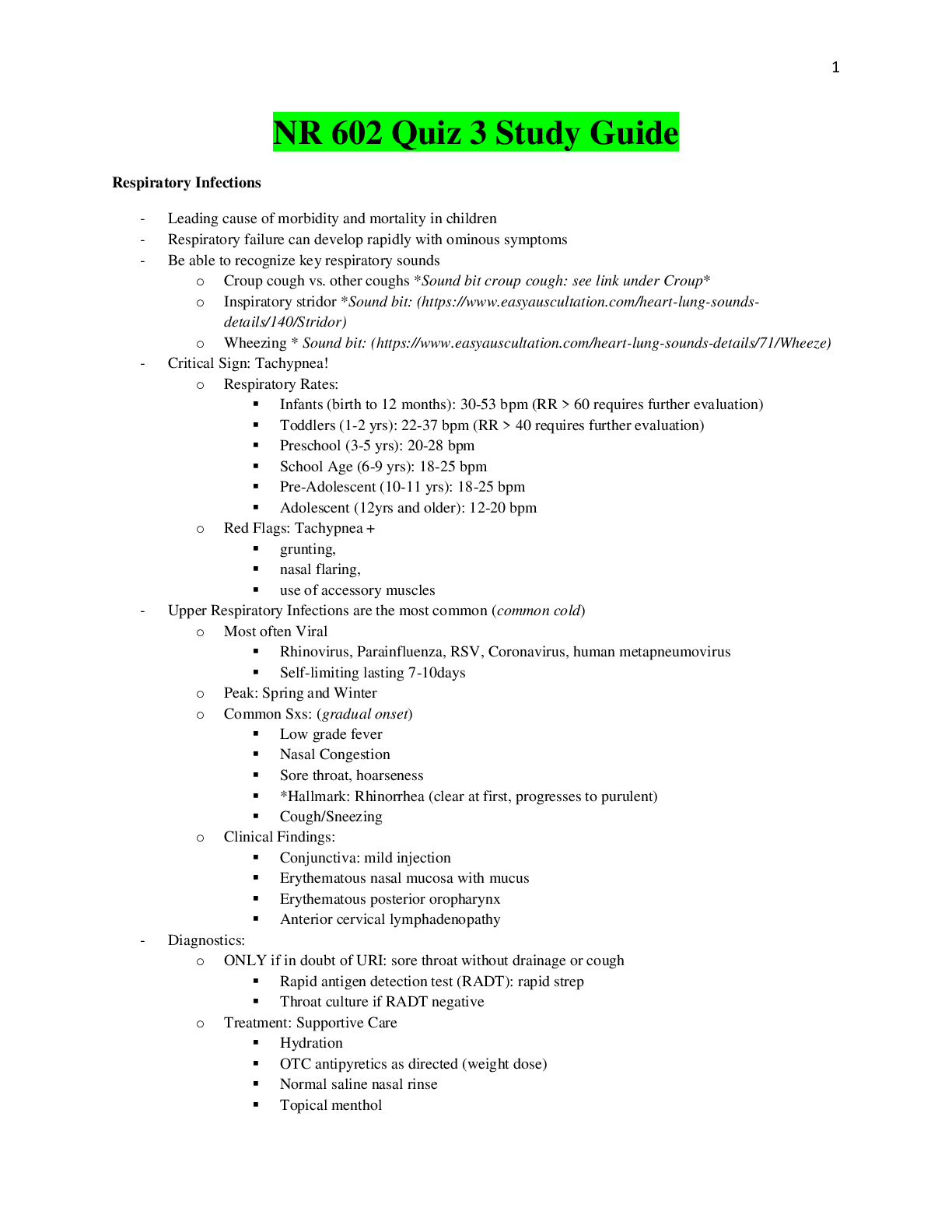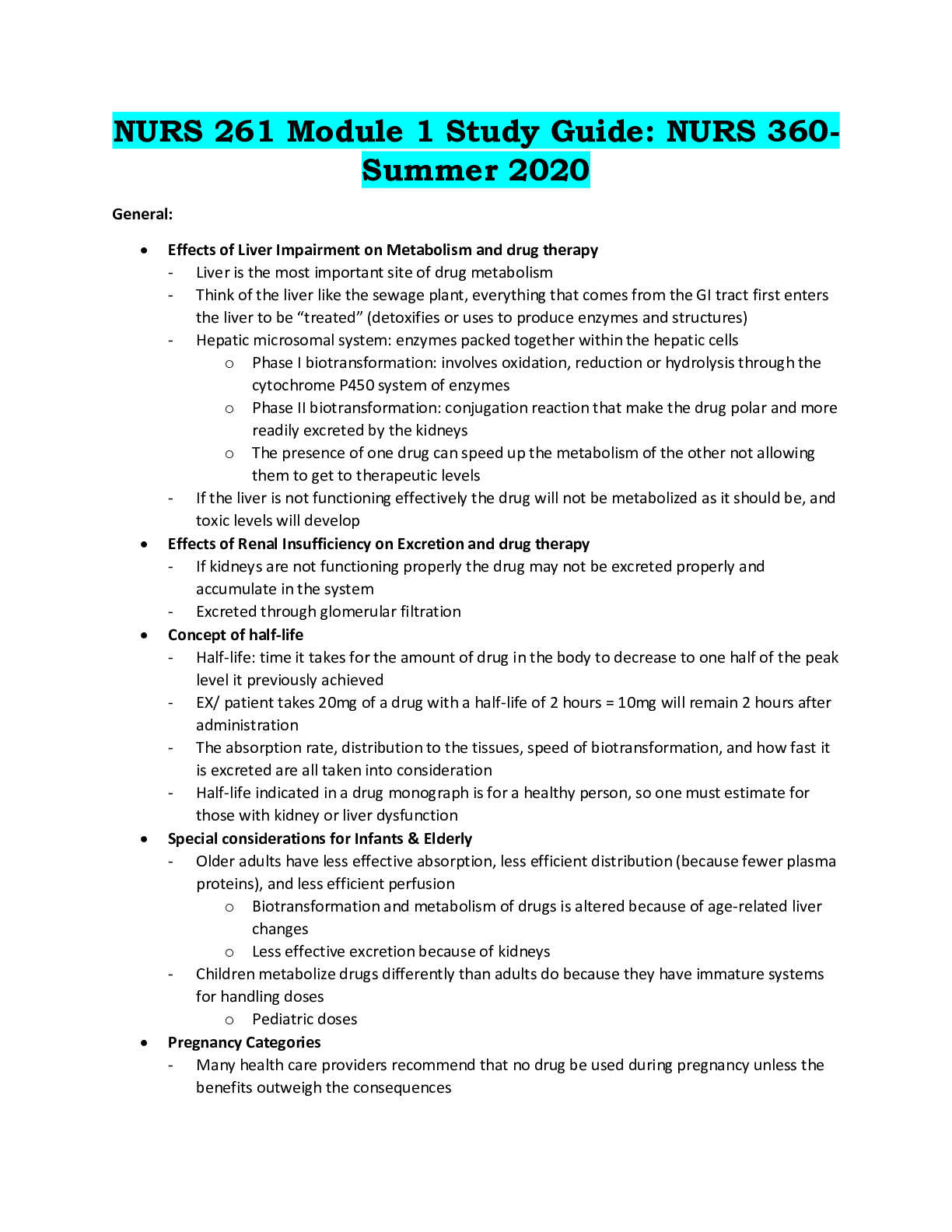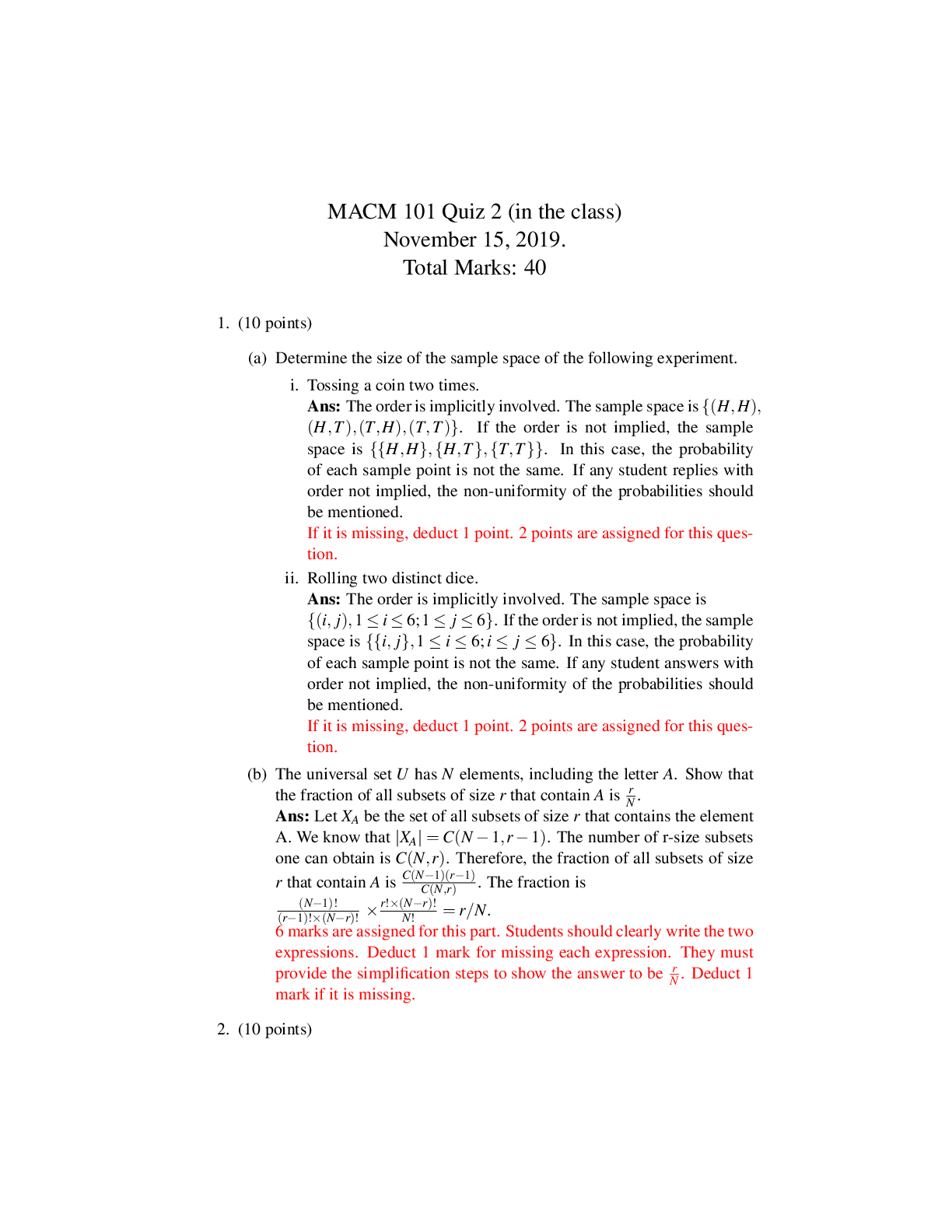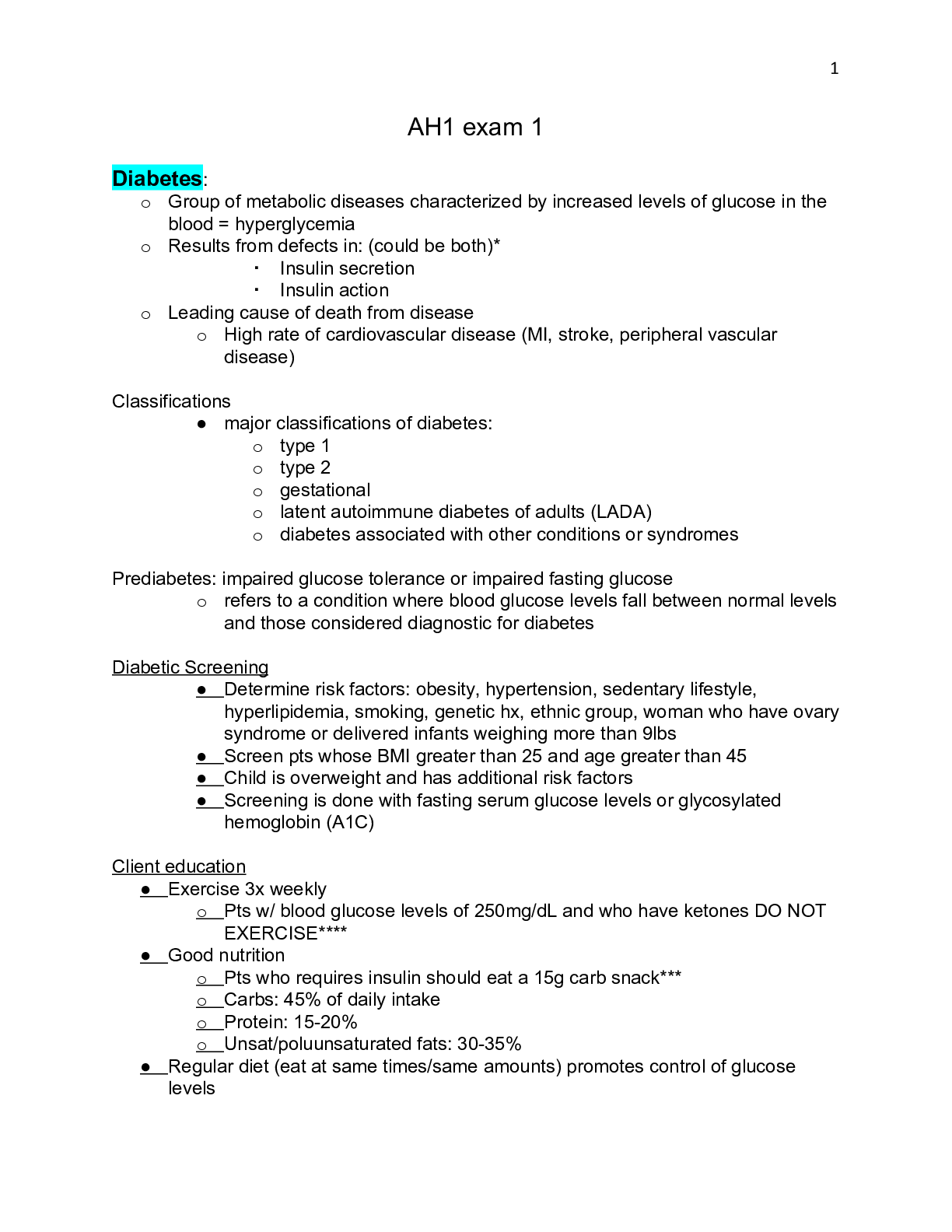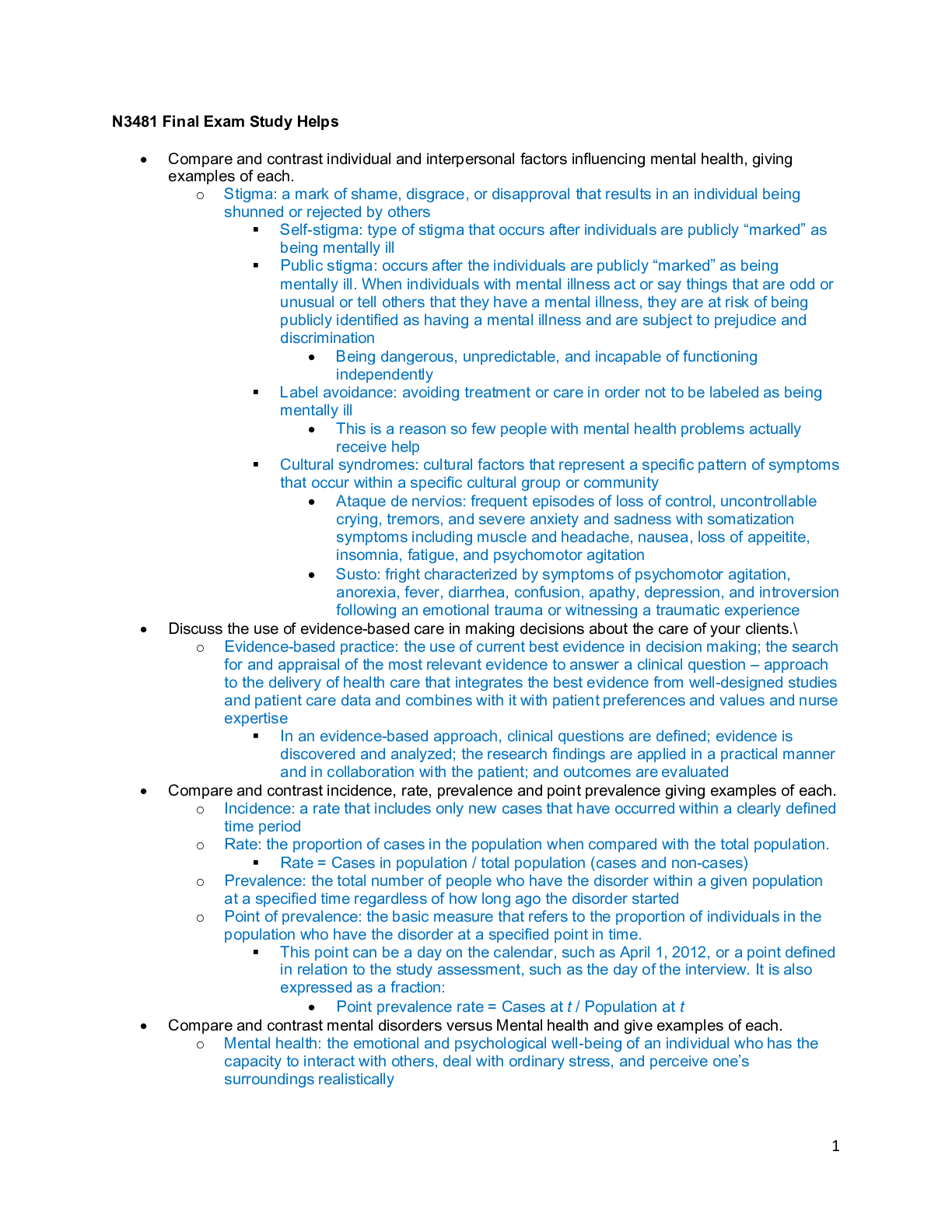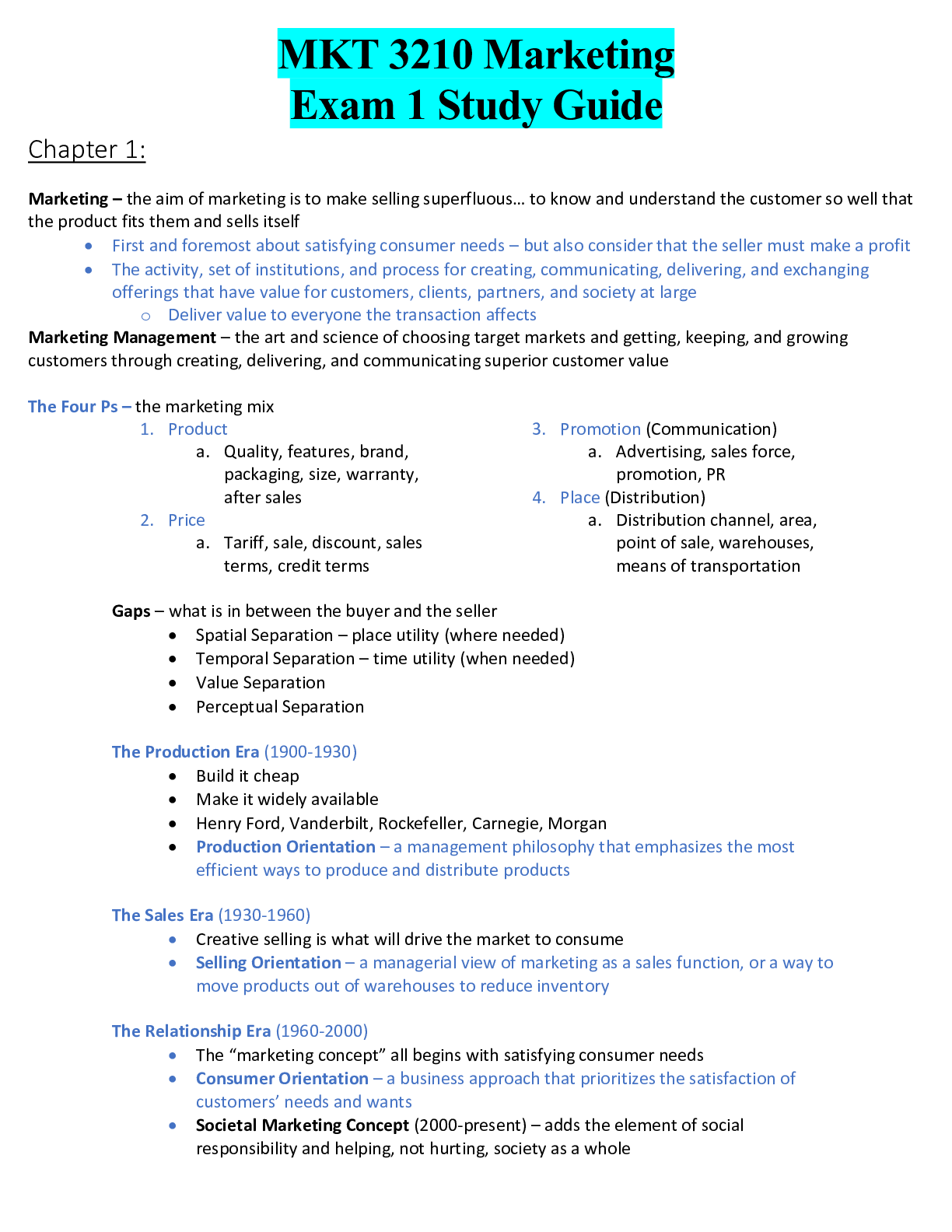Marketing > STUDY GUIDE > MKT 3210 EXAM 2 VOCAB STUDY GUIDE (All)
MKT 3210 EXAM 2 VOCAB STUDY GUIDE
Document Content and Description Below
MKT 3210 EXAM 2 VOCAB STUDY GUIDE Chapter 4: Market research ethics – taking an ethical and aboveboard approach to conducting market research that does no harm to the participant in the proc... ess of conducting the research Database – an organized collection (often electronic) of data that can be searches and queried to provide information about contacts, products, customers, inventory, and more Marketing information system (MIS) – a process that first determines what information marketing managers need and then gathers, sorts, analyses, stores, and distributes relevant and timely marketing information to system users Intranet – an internal corporate communication network that uses Internet technology to link company departments, employees, and databases Market intelligence systems – a method by which marketers get information about what‟s going on in the world that is relevant to their business Reverse engineering – the process of physically deconstructing a competitor‟s product to determine how it‟s put together Market research – the process of collecting, analyzing, and interpreting data about computers, competitors, and the business environment in order to improve marketing effectiveness Syndicated research – research by firms that collect data on a regular basis and sells the reports to multiple firms Custom research – research conducted for a single firm to provide specific information its managers need Marketing decision support system (MDSS) – the data, analysis software, and interactive software that allow managers to conduct analyses and find the information they need Data – raw unorganized facts that need to be processed Information – interpreted data Customer insights – the collection, deployment, and interpretation of information that allows a business to acquire, develop, and retain their customers Research design – a plan that specifies what information marketers will collect and what type of study they will do Secondary data – data that have been collected for some purpose other than the problem at hand Primary data – data from research conducted to help make a specific decision Exploratory research – a technique that marketers use to generate insights for future, more rigorous studies Focus group – a product-oriented discussion among a small group of consumers led by a trained moderator Market research online community (MROC) – a privately assembled group of people, usually by a market research firm or department, utilized to gain insight into consumer sentiments and techniques Case study – a comprehensive examination of a particular firm or organization Ethnography – an approach to research based on observations of people in their own homes or communities Descriptive research – a tool that probes more systematically into the problem and bases its conclusions on large numbers of observations Cross-sectional design – a type of descriptive technique that involves the systematic collection of quantitative information Longitudinal design – a technique that tracks the responses of the same sample of respondents over time Causal research – a technique that attempts to understand cause-and-effect relationships Experiments – a technique that tests predicted relationships among variables in a controlled environment Neuromarketing – a type of brain research that uses technologies such as functional magnetic resonance imaging (fMRI) to measure brain activity to better understand why consumers make the decisions they do Telemarketing – the use of the telephone to sell directly to consumers and business customers Mall intercept – a study in which researches recruit shoppers in malls or other public areas Unobtrusive measures – measuring traces of physical evidence that remain after some action has been taken Mechanical observation – a method of primary data collection that relies on machines to capture human behavior in a form that allows for future analysis and interpretation Eye tracking technology – a type of mechanical observation technology that uses sensors and sophisticated software to track the position and movement of an individual‟s eyes to gain context-specific insights into how individuals interact with and respond to different visual elements and stimuli Cookies – text files inserted by a website sponsor into a web surfer‟s hard drive that allows the sight to track the surfer‟s moves Predictive technologies – analysis techniques that use shopping patterns of large numbers of people to determine which products are more likely to be purchased if others are Bounce rate – a marketing metric for analyzing website traffic. It represents the percentage of visitors who enter the site and “bounce” rather than continuing to view additional pages on the site Validity – the extent to which research actually measures what it was intended to measure Internal validity – the extent to which the results of a research study accurately measure what the study intended to measure by ensuring proper research design, including efforts to ensure that any potentially confounding factors were not included or introduced at any point during the executing of the research study External validity – the extent to which the results of a research study can be generalized to the population its sample was intended to represent, providing a higher level of confidence that the findings can be applied outside of the setting where the research was conducted Reliability – the extent to which research measurement techniques are free of errors Representativeness – the extent to which consumers in a study are similar to a larger group in which the organization has an interest Sampling – the process of selecting respondents for a study Probability sample – a sample in which each member of the population has some known chance of being included Nonprobability sample – a sample in which personal judgement is used to select respondents Convenience sample – a nonprobability sample composed of individuals who just happen to be available when and where the data are being collected Back-translation – the process of translating material to a foreign language and then back to the original language Chapter 5: Customer relationship management (CRM) – a systematic tracking of consumers‟ preferences and behaviors over time to tailor the value proposition as closely as possible to each individual‟s unique wants and needs Mar-tech – short for marketing technology; commonly used to denote the fusion of marketing and technology a particular focus is placed on the application of marketing through digital mediums One-to-one marketing – facilitated by CRM; allows for customization of some aspect of the goods or services that are offered to each customer Touchpoint – any point of direct interface between customers and a company Marketing automation – a group of systems and technologies that can be used to establish a set of rules for handling different marketing related processes in an automated fashion Big data – a popular term to describe the exponential growth of data – both structured and unstructured – in massive amounts that are hard or impossible to process using traditional database technologies Internet of Things – describes a system in which everyday objects are connected ott the internet and in turn are able to communicate information throughout an interconnected system Web scraping – the process of using computer software to extract large amounts of data from websites Sentiment analysis – the process of identifying a follower‟s attitude toward a product or brand by assessing the content or emotion of his or her comments Scanner data – data derived from items that are scanned at the cash register when you check out with your loyalty card Channel partner model – a relationship between channel partners in which a two-way exchange of information between purchasing organizations and their respective vendors is facilitated through shared or integrated IT systems Information overload – a state in which the marketer is buried in so much data that it becomes nearly paralyzing to decide which of the data provide useful information and which do not Data mining – sophisticated analysis techniques to take advantage of the massive amount of transaction information now available Data warehouse – a system to store and process the data that results from datamining Structured data – data that are typically numeric or categorical, can be organized and formatted in a way that is easy for computers to read, organize, and understand, and can be inserted into a database in a seamless fashion Unstructured data – nonnumeric information that is typically formatted in a way that is meant for human eyes and not easily understood by computers Emotion analysis – a sophisticated process for identifying and categorizing the emotions a follower possesses in relation to a product or brand by assessing the content of that communication Data scientist – an individual who searches through multiple, disparate data sources to discover hidden insights that will provide a competitive advantage Marketing analytics – a group of technologies and process that enable marketers to collect, measure, analyze, and assess the effectiveness of marketing efforts Digital marketing channels – the paths of distribution through which a company‟s digital marketing communications can be delivered to reach their respective audiences A/B Test – a method to test the effectiveness of altering one characteristic of a marketing asset Cost-per-click – an online ad purchase in which the cost of the advertisement is charged only each time an individual clicks on the advertisement and is directed to the web page that the marketer placed within the advertisement Cost-per-impression – an online ad purchase in which the cost of the advertisement shows up on a page that the user views Search engine optimization (SEO) – a systematic process to ensure that your firm comes up at or near the top of lists of typical search phrases related to your business Landing page – a single page on a website that is built for a particular direct marketing opportunity Predictive analytics – uses large quantities of data within variables that have identified relationships to more accurately predict specific future outcomes Churn rate – the percentage of a company‟s customers who by the end of a time span can no longer be considered customers of the company Marketing metrics – specific measures that help marketers watch the performance of their marketing campaigns, initiatives, and channels and, when appropriate, serve as a control mechanism Click-through – a metric that indicates the percentage of website users who have decided to click on an advertisement to visit the website or web page associated with it Conversion – signifies an event that occurs on a web page that indicates the meeting of a predefined goal associated with the consumer‟s interaction with that page Cost-per-order – the cost of gaining an order in terms of the marketing investment made to turn a website visitor into a customer who has chosen to make a transaction Margin on sales – the difference between the price at which a product is sold and the cost of the product Chapter 6: Consumer behavior – the process involved when individuals or groups select, purchase, use, and dispose of goods, services, ideas, or experiences to satisfy their needs and desires Involvement – the relative importance of perceived consequences of the purchase to a consumer Perceived risk – the belief that choice of a product has potentially negative consequences, whether financial, physical, or social Problem recognition – the process that occurs whenever the consumer sees a significant difference between his or her current state of affairs and some desired or ideal state; this recognition initiates the decision-making process Information search – the process whereby a consumer searches for appropriate information to make a reasonable decision Evoked set – all of the alternative brands a consumer is aware of when making a decision Consideration set – the alternative brands a consumer seriously considers in making a decision Comparison shopping agents (shopbots) – web applications that help online shoppers find what they are looking for at the lowest price and provide customer reviews and ratings of products and sellers Determinant attributes – the features most important to differentiate and compare among the product choices Evaluate criteria – the dimensions consumers use to compare competing product alternatives Compensatory decision rules – the methods for making decisions that allow information about attributes of competing products to be averaged in some way Heuristics – a mental rule of thumb that leads to a speedy decision by simplifying the process Brand loyalty – a pattern of repeat product purchases, accompanied by an underlying positive attitude toward the brand, based on the belief that the brand makes product superior to those of its competition Consumer satisfaction/dissatisfaction – the overall feelings or attitude a person has about a product after purchasing it Cognitive dissonance – the anxiety or regret a consumer may feel after choosing from among several similar attractive choices Perception – the process by which people select, organize, and interpret information from the outside world Exposure – the extent to which a stimulus is capable of being registered by a person‟s sensory receptors Subliminal advertising – supposedly hidden messages in marketers‟ communications Attention – the extent to which a person devotes mental processing to a particular stimulus Multitasking – moving back and forth between various activities such as emails, TV, instant messages, and so on Rich media – a digital advertising term for an ad that includes advanced features other elements like video and audio that encourage viewers to interact and engage with the content Interpretation – the process of assigning meaning to a stimulus based on prior associations a person has with it and assumptions he or she makes about it Motivation – an internal state that drives us to satisfy needs by activating goal-oriented behavior Hierarchy of needs – an approach that categorizes motives according to five levels of importance, the more basic needs being on the bottom of the hierarch and the higher needs at the top Gamification – a strategy in which marketers apply game design techniques often by awarding the points, badges, or levels to non-game experiences to engage consumers Learning – a relatively permanent change in behavior caused by acquired information or experience Behavioral learning theories – theories of learning that focus on how consumer behavior is changed by external events or stimuli Classical condition – the learning that occurs when a stimulus electing a response is paired with another stimulus that initially does not elicit a response on its own but will cause a similar response over time because of its association with the first stimulus Operant conditioning – learning that occurs as the result of rewards or punishments Data brokers – companies that collect information on consumers, use it to create detailed profiles of individuals, and sell or share the information with others Cognitive learning theory – theory of learning that stresses the importance of internal mental processes and that views people as problem solvers who actively use information from the world around them to master their environment Observational learning – learning that occurs when people watch the actions of others and note what happens to them as a result Attitude – a learning predisposition to respond favorably or unfavorably to stimuli on the basis of relatively enduring evaluations of people, objects, and issues Affect – the feeling component of attitudes; refers to the overall emotional response a person has to a product Sadvertising – advertising designed to arouse more negative emotions to get our attention and create a bond with their products Cognition – the knowing component of attitudes; refers to the beliefs or knowledge a person has about a product and its important characteristics Behavior – the doing component of attitudes; involves a consumer‟s intention to do something, such as the intention to purchase or use a certain product Personality – the set of unique psychological characteristics that consistently influences the way a person responds to situations in the environment Self-concept – an individual‟s self-image that is composed of a mixture of beliefs, observations, and feelings about personal attributes Family life cycle – a means of characterizing consumer within a family structure on the basis of different stages through which people pass as they grow older Lifestyle – the patter of living the determines how people choose to spend their time, money, and energy and that reflects their values, tastes, and preferences Psychographics – the use of psychological, sociological, and anthropological factors to construct market segments Activities, interests, and opinions (AIOs) – measures of consumer activities interest, and opinions used to place consumers into dimensions Sensory marketing – marketing techniques that link distinct sensory experiences such as a unique fragrance with a product or services Sensory branding – the use of distinct sensory experiences not only to appeal to customers but also to enhance their brand Time poverty – consumers‟ belief that they are more pressed for time than ever before Culture – the values, beliefs, customs, ad tastes a group of people values Subculture – a group within society whose members share a distinctive set of beliefs, characteristics, or common experiences Microcultures – groups of consumers who identify with a specific activity or art form Consumerism – a social movement that attempts to protect consumers from harmful business practices Conscientious consumerism – a continuation of the consumerism movement in which consumers are much more mindful of environmental issues in their daily purchases and marketers support consumerism issues in their advertising Social class – the overall rank or social standing of groups of people within a society according to the value assigned to factors such as family background, education, occupation, and income Status symbol – visible markers that provide a way for people to flaunt their membership in higher social classes Mass class – the hundreds of millions of global consumers who now enjoy a level of purchasing power that‟s sufficient to let them afford high-quality products except for bigticket items like college educations, housing, or luxury cars Reference group – an actual or imaginary individual or group that has a significant effect on an individual‟s evaluations, aspirations, or behavior Opinion leader – a person who is frequently able to influence others‟ attitudes or behaviors by virtue of his or her active interest and expertise in one or more product categories Gender roles – society‟s expectations regarding the appropriate attitudes, behaviors, and appearance for men and women Business-to-business (B2B) markets – the group of customers that include manufacturers, wholesalers, retailers, and other organizations Organizational markets – another name for business-to-business markets Producers – the individuals or organizations that purchase products for use in the production of other goods and services Resellers – the individuals or organization that buy finished goods for the purpose of reselling, renting, or leasing to others to make a profit and to maintain their business operations Government markets – the federal, state, county, and local governments that buy gods and services to carry out public objectives and to support their operations North American Industry Classification System (NAICS) – the numerical coding system that the United States, Canada, and Mexico use to classify firms into detailed categories according to their business activities Derived demand – demand for business or organizational products caused by demand for consumer goods or services Inelastic demand – demand in which changes in price have little or no effect on the amount demanded Joint demand – demand for two or more goods that are used together to create a product Buyclass – one of three classifications of business buying situations that characterizes the degree of time and effort required to make decisions Straight rebuy – a buying situation in which business buyers make routine purchases that require minimal decision making Modified rebuy – a buying situation classification used by business buyers to categorize a previously made purchase that involves some change and that requires limited decision making New-task buy – a new business-to-business purchase that is complex or risky and that requires extensive decision making Buying center – the group of people in an organization who participate in a purchasing decision Initiator – begins the buying process by first recognizing that the firm needs to make a purchase User – the member of the buying center who actually needs the product Gatekeeper – the person who controls the flow of information to other members Influencer – affects the buying decision when he or she dispenses advice or shares expertise Decider – the member of the buying center who makes the final decision Buyer – the person who has responsibility to execute the purchase Product specifications – a written description of the quality, size, weight, and other details required of a product purchase Customer reference program – a formalized process by which customers formally share success stories and actively recommend products to other potential clients, usually facilitated through an online community Single sourcing – the business practice of buying a particular product from only one supplier Multiple sourcing – the business practice of buying a particular product from several different suppliers Reciprocity – a trading partnership in which two firms agree to buy from one another Outsourcing – the business buying process of obtaining outside vendors to provide goods or services that otherwise might be supplied in house Offshoring – the process by which companies contract with companies or individuals in remote places like China or India to perform work they used to do at home Reverse marketing – a business practice in which a buyer firm attempts to identify suppliers who will produce products according to the byer firm‟s specifications Business-to-business (B2B) e-commerce – online exchanges between companies and individual consumers Intranet – an internal corporate communication networks that uses internet technology to link company departments, employees, and databases Extranet – a private, corporate computer network that links company departments, employees, and databases to suppliers, customers, and others outside the organization Malware – software designed specifically to damage or disrupt computer systems Firewall – a combination or hardware and software that ensures that only authorized individuals gain entry into a computer system Encryption – the process of scrambling a message o that only another individual (or computer) with the right “key” can unscramble it Chapter 7: Market fragmentation – the creation of many consumer groups due to diversity of distinct needs and wants in modern society Target marketing strategy – dividing the total market into different segments on the basis of customer characteristics, selecting one or more segments, and developing products to meet the needs of those specific segments Segmentation – the process of dividing a larger market into smaller pieces based on one or more meaningful shared characteristics Segmentation variables – dimensions that divide the total market into fairly homogeneous groups, each with different needs and preferences Demographics – statistics that measure observable aspects of a population, including size, gender, ethnic, group, income, education, occupation, and family structure Generational marketing – marketing to members of a generation, who tend to share the same outlook, values, and priorities Generation Z – the group of consumers born after 1994 Digital natives – individuals who spend a big chunk of their time online, so they expect brands to engage them in two-way digital conversations Generation Y (millennials) – the group of consumers born between 1979 and 1994 Generation X – the group of consumers born between 1965 and 1978 Baby boomers – the segment of people born between 1946 and 1964 Metrosexual – a straight, urban male who is keenly interested in fashion, home design, gourmet cooking, and personal care Buying power – a concept in segmentation that can help marketers to determine how to better match different products and versions of products to different consumer groups based on an understanding of what discretionary and nondiscretionary allocations of funds they are able to make Content marketing – the strategy of establishing thought leadership in the form of bylines, blogs, commenting opportunities, videos, sharable social images, and infographics Cultural diversity – a management practice that actively seeks to include people of different sexes, races, ethnic groups, and religions in an organization‟s employees, customers, suppliers, and distribution channel partners Geographic segmentation – an approach in which marketers tailor their offerings to specific geographic areas because people‟s preferences often vary depending on where they live Geographic information system (GIS) – a system that combines a geographic map with digitally stored data about the consumers in a particular geographic are Geodemography – a segmentation technique that combines geography with demographics Geotargeting – determining the geographic location of a website visitor and delivering different content to that visitor based on his or her location Micromarketing – the ability to identify and target very small geographic segments that sometimes amount to individuals Psychographics – the use of psychological, sociological, and anthropological factors to construct market segments VALS – a psychographic segmentation system that divides US adults into eight groups according to what drives them psychologically as well as by their economic resources Gamer segment – the consumer segment that combines a psychographic/lifestyle component with a heavy dose of generational marketing Badge – a milestone or reward earned for progressing through a video game Behavioral segmentation – a technique that divides consumers into segments on the basis of how they act towards, feel about, or use a good or service 80/20 rule – a marking rule of thumb that 20 percent of purchasers account for 80 percent of a product‟s sales Usage rate – a measurement that reflects the quantity purchased or frequency of use among consumers of a particular product or service Long tail – a new approach to segmentation based on the idea that companies can make money by selling small amounts of items that only a few people want, provided they sell enough different items Usage occasions – an indictor used in behavioral market segmentation based on when consumers use a product most Organizational demographics – organization-specific dimensions that can be used to describe, classify, and organize different organizations for the purpose of segmenting business-to-business markets Targeting – a strategy in which marketers evaluate the attractiveness of each potential segment and decide in which of these groups they will invest resources to try to turn them into customers Target market – the market segments on which an organization focuses its marketing plan and toward which it directs its marketing efforts Segment profile – a description of the „typical‟ customer in a segment Undifferentiated targeting strategy – appealing to a broad spectrum of people Differentiated targeting strategy – developing one or more products for each of several distinct customer groups and making sure these offering are kept separate in the marketplace Concentrated targeting strategy – focusing a firm‟s efforts on offering one or more products to a single segment Customized marketing strategy – an approach that tailors specific products and the messages about them to individual customers Mass customization – an approach that modifies a basic good or service to meet the needs on an individual Positioning – developing a marketing strategy to influence how a particular market segment perceives a good or service in comparison to the competition Positioning statement – an expression of a product‟s positioning that is internally developed and maintained in order to support the development of marketing communication that articulates the specific value offered by a product Repositioning – redoing a product‟s position to respond to marketplace changes Retro brands – a once-popular brand that has been revived to experience a popularity comeback, often riding a wave of nostalgia Brand personality – a distinctive image that captures a good‟s or service‟s character and benefits Brand anthropomorphism – the assignment of human characteristics and qualities to a brand Perceptual map – a technique to visually describe where brands are “located” in consumers‟ minds relative to competing brands [Show More]
Last updated: 2 years ago
Preview 1 out of 11 pages

Buy this document to get the full access instantly
Instant Download Access after purchase
Buy NowInstant download
We Accept:

Reviews( 0 )
$5.00
Can't find what you want? Try our AI powered Search
Document information
Connected school, study & course
About the document
Uploaded On
May 16, 2021
Number of pages
11
Written in
Additional information
This document has been written for:
Uploaded
May 16, 2021
Downloads
0
Views
108

